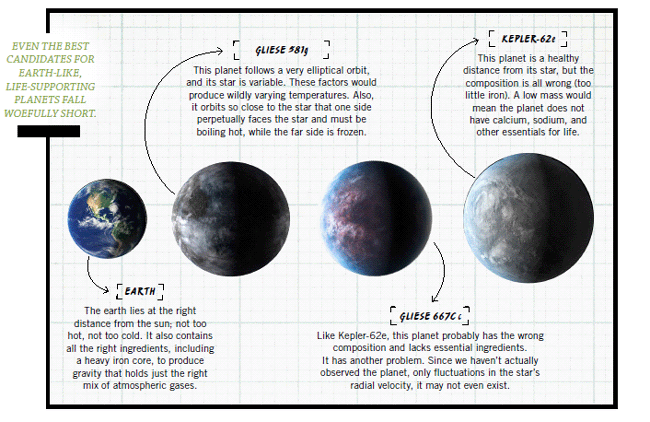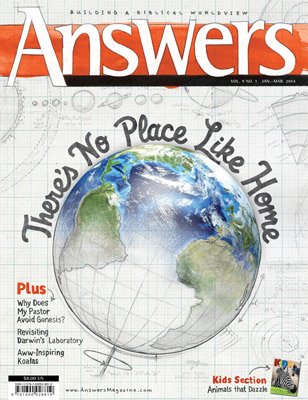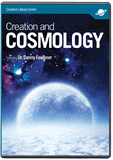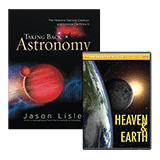Just Right for Life
Special Feature: There’s No Place Like Home
We’re just one out of millions of planets where life is likely to exist. You’ll hear this claim more and more. Don’t believe it. Even the best planets found so far don’t come close to reaching the minimum requirements, and the list is longer than you think.
A powerful motive drives the ongoing, costly search for life on other worlds. If life is unique to the earth, then that makes our planet special and implies a Creator. But this thought repels unregenerate minds. If life arose naturally as they believe, then we should expect to find life on many other planets throughout the universe.
Hopes of finding life within our own solar system have been dashed so far, but that has not diminished the astronomical zeal. In 2009 NASA launched the Kepler telescope—costing over half a billion dollars—to monitor 145,000 stars for evidence of orbiting planets. The results are astounding: over 3,500 candidates were identified in Kepler’s small survey. Yet Kepler was able to detect just a small fraction of the planets orbiting its target stars. Correcting for its limited view and extending the result to other stars, researchers can estimate how many planets exist. Our Milky Way galaxy alone may host as many as 100 billion planets.
Despite the hype, the survey is verifying what our solar system has already shown us—that there’s no place like home.
What Is Life, Anyway?
For decades evolutionists thought that life arose in a warm, comfortable pool of water—the sort of environment where life thrives on earth today. They had to change their tune, however, as the harsh conditions on other planets unfolded. Repeated space probes have shown how hostile Mars and other planets are, though many people have never given up.
Over the past thirty years scientists have found what appears to be an inkling of hope. Extremophiles are organisms that manage to survive in earth’s most extreme environments, such as the high temperatures of hydrothermal vents on the seafloor, the high pressure deep in rock, and the cold and dark of lakes buried beneath Antarctic ice. Now many scientists think that life began in these hostile places.
The hope is that isolated locations on other planets like Mars may harbor organisms similar to earth’s extremophiles. Similar arguments persist for some of Jupiter’s and Saturn’s moons, where liquid water might exist far below their surfaces. Since liquid water appears to be a necessary ingredient for life, the evolutionary reasoning is that life probably develops wherever liquid water exists.
Yet notice how low the bar is set. Secular astronomers aren’t actually looking for life itself but the places where life could theoretically survive. Even that bare minimum—the right conditions for liquid water—has proven very hard to find.
Biblical creationists have a much higher bar. God’s Word refers to animals, not plants or microorganisms, as “living things.” And the basic needs of animal life are almost endless. This does not diminish the fact that extremophiles are amazing creations in their own right, with special designs that enable them to survive in hostile conditions that would kill any other form of life on earth. (So much for making it easier to explain the miracle of evolution.)
Scientists have coined a new term, exobiology, to refer to the study of life beyond the earth. Many conferences and papers have been dedicated to exobiology, though there is no evidence that life exists on any other planets. Apparently, exobiology is a science for which there is no data.
Which Planets Can Support Life?
Astronomers had long speculated that planets might exist outside the solar system, but the first exoplanet was confirmed only twenty years ago. At the time of this writing there are nearly one thousand confirmed exoplanets. (The Kepler telescope accounts for more than a quarter of the detections so far, and more probably will follow.) Yet exoplanet discovery is indirect, and we know nothing of these planets beyond their masses and their distances from their respective stars.
Though this information is minimal, it is sufficient to show that most planets don’t meet the basic conditions of an extremophile-friendly planet.
Just the Right Distance (Not Too Hot, Not Too Cold)
Noting the necessity of liquid water for life, astronomers have defined habitable zones around other stars. The habitable zone is the narrow region of space around a star where liquid water is possible on a planetary surface. If a planet orbits closer than the habitable zone, then the planet will be too hot for liquid water. But if a planet is outside the habitable zone, any water present will freeze.
This is true of the solar system. Venus is too close to the sun and hence too hot for liquid water. Mars is too far from the sun, so its water is mostly frozen. But the earth is in the middle of the sun’s habitable zone. A star’s habitable zone is very narrow, and few exoplanets thus far discovered are located within their respective stars’ habitable zones.
Just the Right Mass (to Hold the Right Atmosphere)
But being in the habitable zone is not enough. The earth’s moon is in the right zone but is sterile. The problem is that the moon has too little mass (and hence too little gravity) to keep any significant atmosphere. Liquid water cannot exist in the vacuum of space, as on the lunar surface. But if a planet is too massive, it retains the wrong kind of atmosphere, such as the poisonous, lighter gases on Jupiter. For a planet or moon to support life, it must have just the right mass.
Just the Right Composition
The right distance from the sun and the proper mass are still not enough. Even if the earth’s moon had sufficient mass to hold the same kind of atmosphere as the earth, it would still not support life. The moon lacks many of the necessary elements found on earth, such as iron.

The Example of Gliese 581g
Astronomers have found a few exoplanets that appear to be within the habitable zones of their respective stars. However, after news media herald each discovery as possibly harboring life, the case for each quietly erodes. For instance, in 2010 astronomers announced the discovery of Gliese 581g orbiting in the habitable zone of the star Gliese 581. Ignored in all the news coverage were three life-threatening problems.
Unstable Orbit (Varying Temperature)
One problem is that this planet follows a very elliptical orbit, which alternately takes the planet much closer and much farther than average from the star. This would produce wildly varying surface temperatures.
No Rotation (Boil-or-Freeze Syndrome)
Second, the star is faint, so the planet orbits very close to it. Such a close orbit probably produces synchronous rotation on the planet. This means that one side of the planet always faces the star while the other side always faces away. As a result, one side of the planet would be perpetually very hot while the other side likely would be frozen all the time.
Variable Star Brightness (Varying Radiation)
Third, Gliese 581 is a variable star, which means that it varies in brightness. This could have devastating effects on life. The temperature on the planet changes as the star varies in brightness. Furthermore, the change in brightness probably is associated with strong magnetic fields, which likely produce harmful radiation.
We must consider all of these sorts of factors in addition to the habitable zone when discussing whether a particular extrasolar planet might be able to support life. We also need to take into account the astronomers’ reliance on indirect evidence for such distant objects. Indeed, further studies have seriously called into question whether Gliese 581g even exists.
Astronomers have found only a handful of other planets in their stars’ habitable zones, and Gliese 581g is one of the best. Assuming that these other planets exist, all of them fall short in several ways. The most common problem is that most are several times more massive than the earth. These “super earths” likely have the wrong atmospheric composition to support life. However, secular scientists are not discouraged, as they blithely continue searching for the next elusive planet that could technically support an extremophile.
The creation model suggests that the earth alone sustains life. Life does not arise naturally but exists only where God chose to create it.
The creation model suggests that the earth alone sustains life. We believe that life does not arise naturally but exists only where God chose to create it. Could God have made life elsewhere? Certainly He could, but that isn’t the question. The question is whether He chose to do so. God specially made the earth to be inhabited (Genesis 1; Isaiah 45:18). We and the planet that we live on are divine creations, making us unique.
If God made life on other planets, it raises complex questions about the Fall and the Curse. Romans 8:22 tells us that the entire cosmos suffers from the effects of the Fall and the Curse, so would Adam’s sin spread death to other planets? Did God create sentient beings on other planets? If they have souls, are they in need of salvation?
The Bible clearly makes man the center of His attention, so we can be sure that no extraterrestrial creatures are made in the image of God, as we are. They would not be the objects of God’s gracious salvation through the death of His uniquely begotten Son, Jesus Christ.
On the other hand, the evolutionary worldview must assume that life naturally arises wherever conditions are suitable. But what does the science (data) say? Of the eight planets of the solar system, only one, the earth, is suitable for life. Of the nearly one thousand currently known extrasolar planets, only a very few could possibly sustain life. And even those few are extremely doubtful, as the next three articles will explore in greater detail.
Thus far, the search for life on other planets has agreed with the prediction of the creation model, but it has contradicted the evolutionary worldview. The earth has innumerable amazing properties, not least of which are its two “great lights”—the sun and moon—which uniquely display the Creator’s perfect provision for life on earth.
Special Feature: There’s No Place Like Home
- Just Right for Life
- Not Just Another Star
- A Perfect Partner
- A Unique Blend
Answers Magazine
January – March 2014
Placed safely in our solar system’s “goldilocks zone” and engineered with the perfect balance of atmosphere, chemicals, and water, our earth was miraculously formed to be inhabited (Isaiah 45:18). This issue examines the earth’s unique suitability for life. We’ll also investigate what seminaries are actually teaching our pastors, the possibility that viruses could be beneficial, and more.
Browse Issue SubscribeRecommended Resources

Answers in Genesis is an apologetics ministry, dedicated to helping Christians defend their faith and proclaim the good news of Jesus Christ.
- Customer Service 800.778.3390
- © 2024 Answers in Genesis







